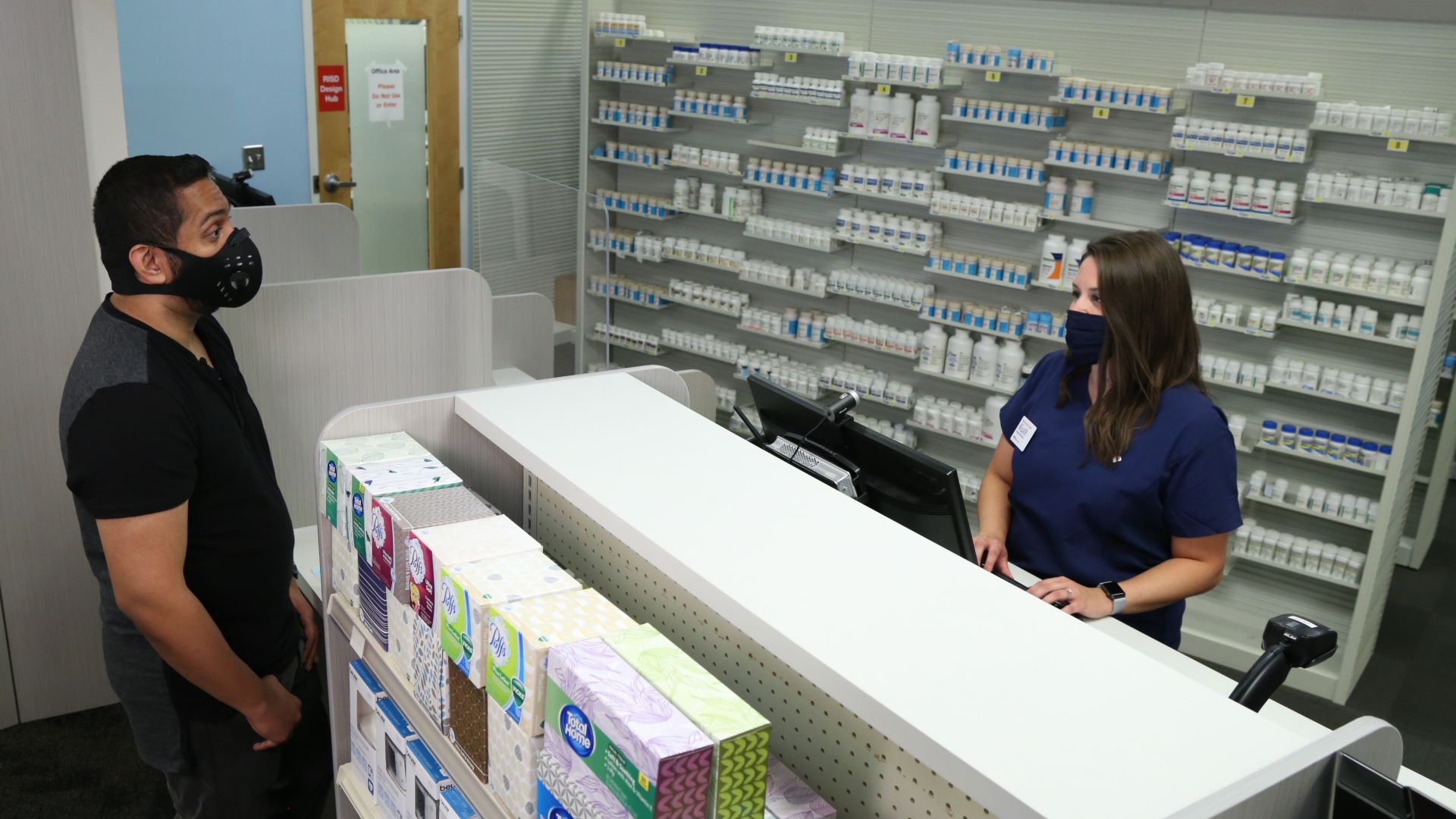At the end of his tenure at Walgreens, Richard was working over 12 hour days to try to meet the escalating demands put on him.
A former pharmacy manager of a southern Maine Walgreens location, Richard — who asked to be referred to by only his first name to avoid potential retribution in his industry — worked for the company for seven years before he left in 2021 to work for a hospital. He had jumped from location to location to fill in when help was needed and endured a loss of staff and budget cuts while pressured to write more prescriptions each day increased.
Still, he said, he stuck with the job even as the coronavirus pandemic ratcheted up the pressure, adding drive-thru testing and eventually vaccinations to an overburdened plate. Richard voiced his concerns about the conditions, which to him were stressful and unsafe. He said the company then changed his schedule last-minute and wrote him up for an unexcused absence when he was hospitalized for a diabetic issue, despite having sick days.
“You’re telling me to jeopardize my health,” he said, “and I didn’t want to put myself in that position.”
Some of Richard’s situation is unique, but the overarching themes of being overworked and understaffed as a pharmacist are not, current and former pharmacists told The Maine Monitor. Increased expectations of output and more reliance on technicians rather than fully trained pharmacists were increasingly normal for chain pharmacies prior to the pandemic, and those pressures got worse during the first two years of the crisis. They have not abated even as the country has largely reverted to normal.
Their experiences illustrate how complicated the job has become. Pharmacists are a key part of the health care sector, often giving health advice and making on-the-fly recommendations for patients, in addition to dispensing vital medication. Their role has only grown since the COVID-19 vaccination campaign kicked into gear.
The stresses on the industry have surfaced in another way, as well. In November, The Maine Monitor reported that state regulators had fined Walgreens $68,000 in 2022 for violating state staffing and operating hours laws at 10 locations, an apparent sign of the labor shortage. CVS faced a smaller number of fines for similar violations.
RELATED: Walgreens paid $68,000 in penalties after failing to meet staffing requirements
Walgreens did not respond by press time for this story. But the company made a drastic change last year to how it evaluates its pharmacy staffers’ performance to no longer emphasize task-based metrics. The company said at the time the change was made due to staff feedback and improving customer service.
The workforce of pharmacists looks to be waning somewhat: the Bureau of Labor Statistics estimated that the number of jobs available for pharmacists nationally is expected to increase by two percent for 2021 to 2031, slower than the average for all occupations. About 13,600 job openings were projected for each year as people leave the industry or retire, meaning that chain and smaller pharmacies struggle to hire pharmacists and the support staff they rely on.
These challenges may have peaked during the pandemic, but they precede it as well. In 2019, 71 percent of practicing pharmacists reported their workload was high or “excessively high,” according to the National Pharmacist Workforce Study commissioned by the Pharmacy Workforce Center. That was an increase of 5 percent from 2014. Ninety-one percent of chain pharmacists reported high workloads, compared with 48 percent in independent community pharmacies.
The study also found that the quality of work-life balance among pharmacists had decreased since 2019. The three most common stressors were having too much work, being understaffed and fearing patient harm due to medical error.
Those challenges are not isolated to corporate pharmacies. The National Community Pharmacists Association, which represents the smaller and usually more locally based independent and community pharmacies, reported in an August survey that three-quarters of their members were having a hard time filling open positions, especially for technicians. That has led to higher payrolls and longer wait times for patients to fill prescriptions, the survey found.
“Whether in a chain or a community pharmacy, it’s a high-pressure situation,” said John Beckner, senior director of strategic initiatives at the National Community Pharmacists Association.
William Doucette, a professor of health policy at the University of Iowa who helped conduct the National Pharmacist Workforce Study, said the problem stems from increased pressure for pharmacies to make money. Pharmacy benefit managers, separate organizations that process prescription drug claims, have decreased the reimbursement to pharmacies for drug dispensing in recent years, he said, which results in less money for the pharmacy business.
Retailers have largely responded by trying to reduce staff, while some smaller stores have tried to diversify revenue streams, Doucette said. The U.S. Department of Health and Human Services determined in 2020 that the Public Readiness and Emergency Preparedness Act allowed pharmacy technicians to give COVID-19 shots, which should have alleviated some of the stress on pharmacists. But those jobs became more difficult to fill as many people left the health care industry during the pandemic.
Doucette said there have been some responses to the challenges facing pharmacists, such as Walgreens’ changes around metrics. But he said preliminary data from the 2022 pharmacist survey showed one-third of pharmacists had changed jobs from 2020 to 2022, and working conditions had not yet improved.
“It’s not just the chains being bullies,” he said. “Their strategy just swamped some settings.”
There are upsides to the job, such as when patients greet you with hugs or send you holiday cards, said Abdullah Al-Fdeilat. A pharmacist at Shaw’s in Bangor, he spoke out about the pressures facing pharmacists in 2020 and was frustrated that more responsibilities, not fewer, have been foisted on his profession since then.
He now discourages people from going to pharmacy school, saying a shrinking market and the stressors make it not worthwhile.
“It is very stressful to think that any small action in your job could lead to people getting hurt,” he said.
Shaw’s pharmacies in Maine are fully staffed with pharmacists and technicians, said Teresa Edington, a spokesperson for the supermarket chain. The company is also offering benefits such as four-day workweeks to give employees more of a work-life balance.
“We are grateful for our Pharmacy team members for the dedicated care they provided throughout the pandemic and beyond,” she said.
Lee Ohmart, a retired Brewer pharmacist, said he still hears from colleagues at other pharmacies that they work 60 to 80 hours a week to meet their employers’ demands. One colleague at a chain pharmacy told him he had quit without job prospects because he could no longer take the stress.
The pressure and focus on generating revenue is demoralizing for a profession that is supposed to be centered around helping people, Ohmart said. He feels the burnout pharmacists are feeling is due in part to a sense of “moral injury,” being forced by employers to do their job in a way that conflicts with how they believe it is meant to be done and puts others at risk.
To look at the challenges facing pharmacists, Ohmart worked with Rep. Kevin O’Connell, D-Brewer, to propose a resolution requiring the Board of Pharmacy to investigate pharmacist working conditions. O’Connell said he is not sure when it will get a public hearing but hopes it will bring the challenges that workers face to light.
What that would look like is not clear yet. Joan Cohen, the deputy commissioner for the Maine Department of Financial and Professional Regulation, said the office is aware of the workforce challenges in pharmacy but the board does not have jurisdiction over workplace practices. She said it would be premature to comment on the bill itself.
Ohmart hopes it changes something, before people get hurt.
Caitlin Andrews covers state government and general assignment stories for The Maine Monitor. Reach her with other story ideas by email: gro.r1764062826otino1764062826menia1764062826meht@1764062826nilti1764062826ac1764062826.








